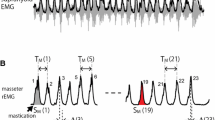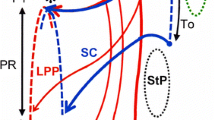Abstract
THE movements of the hyoid bone and the larynx during swallowing are only well established for man1–3. Their movements, if any, during mastication in man and in other mammals have been neglected. The hyoid is suspended from the cranium, above and behind, by the posterior suprahyoid muscles (stylohyoid and the posterior belly of digastric) and from the symphyseal region of the jaw in front by the anterior suprahyoid muscles (anterior belly of digastric, mylohyoid, geniohyoid and the more inferior fibres of genioglossus). The infrahyoid, or ‘strap’ muscles of the neck connect the hyoid with the sternum directly by the sternohyoid and indirectly through the thyroid cartilage of the larynx (thyrohyoid and sternothyroid) as well as with the scapula (omohyoid). This arrangement of the hyoid apparatus is found in all mammals, except that the digastric may not have a direct hyoid connection4: a situation occasionally found in man2. These three groups of muscles (anterior and posterior suprahyoids and infrahyoids) are recognised, on the basis of anatomical, cinematographic5 and electromyographic6 studies of human deglutition, as acting in combination first to elevate and then to depress the hyoid and larynx in swallowing. The posterior suprahyoids and the infrahyoids are also classically regarded1,2 as acting to “stabilise”1 or “fix”2 the hyoid so that the anterior suprahyoids, and particularly the anterior belly of digastric6,7, can pull the symphyseal region of the jaw towards the hyoid and open the mouth. Mandibular depression follows the power stroke8 of every chewing cycle. The classical view of the hyoid apparatus is of a somewhat immobile bone and a group of muscles whose only active role is in swallowing. This concept may have led to the view that, since the omohyoid in man made such an uncertain contribution to hyoid movement or control of hyoid position, a “specific”1and “speculative”2 function should be attributed to this muscle; namely the tensing of the cervical fascia to assist prolonged inspiration during forced respiration. The latest edition of Gray's Anatomy2 comments, “so far no useful data in regard to the hyoid musculature as a whole have been contributed by electromyographers” (page 508).
Similar content being viewed by others
References
Last, R. J., Anatomy, Regional and Applied, 2nd ed. (Churchill, London, 1959).
Gray's Anatomy, 35th ed. (edit. by Warwick, R., and Williams, P. L.)(Longmans, London, 1973).
Carslöö, S., Acta anat., 26, 81–93 (1956).
du Chaine, J., Journ. de l'Anat., Paris, 50 (1914–1919).
Whillis, J., J. Anat. Lond., 80, 115–116 (1946).
Doty, R. V., in Handbook of Physiology, 4 (edit. by Code, C. F.), ch. 92, 1861–1902 (American Physiological Society, Washington DC, 1968).
Moyers, R. E., Am. J. Orthodont., 36, 481–515 (1950).
Crompton, A. W., and Hiiemae, K., Zool. J. Linn. Soc., 49, 21–47 (1970).
Basmajian, J. V., and Stecko, G., J. appl. Physiol., 17, 849 (1962).
Hiiemae, K., and Jenkins, F. A., Postilla, 140, 1–40 (1969).
Hiiemae, K., and Kay, R. F., in Symp. fourth Int. Congr. Primat. (edit. by Zingeser, M. R.), 28–64 (Karger, Basle, 1973).
Thexton, A. J., and Hiiemae, K., IADR abstracts L378, PL95 (International Association for Dental Research, London, 1975).
Thexton, A. J., in Clinical and Physiological Aspects of Mastication (edit. by Anderson, D. A., and Matthews, B.) (John Wright, Bristol, in the press).
Author information
Authors and Affiliations
Rights and permissions
About this article
Cite this article
CROMPTON, A., COOK, P., HIIEMAE, K. et al. Movement of the hyoid apparatus during chewing. Nature 258, 69–70 (1975). https://doi.org/10.1038/258069a0
Received:
Accepted:
Issue Date:
DOI: https://doi.org/10.1038/258069a0
- Springer Nature Limited
This article is cited by
-
Electromyography of Swallowing with Fine Wire Intramuscular Electrodes in Healthy Human: Activation Sequence of Selected Hyoid Muscles
Dysphagia (2014)
-
Intrinsic Properties of the Adult Human Mylohyoid Muscle: Neural Organization, Fiber-Type Distribution, and Myosin Heavy Chain Expression
Dysphagia (2005)





